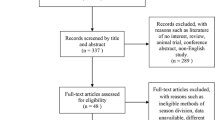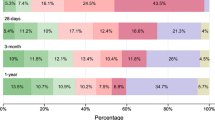Abstract
Data on seasonal differences in stroke incidence are conflicting. Little is known about seasonal variability in etiological stroke subtypes and population-based data on possible trigger factors are lacking. The Ludwigshafen Stroke Study is a prospective population-based stroke registry. All residents of the city of Ludwigshafen who suffer from acute stroke or TIA are registered. Patients with first-ever stroke (FES) were included for the present analysis. Between January 1, 2006 and December 31st, 2010, 1,779 patients (age 71.7 ± 13.4 years (mean + standard deviation; 897 (50.4 %) women) suffered a FES. Incidence for FES was lowest in summer (reference) with significantly higher rates in winter (rate ratio (RR) 1.20, 95 % confidence interval (CI) 1.05–1.37) and spring (RR 1.21 95 % CI 1.06–1.38). First-ever ischemic stroke (FEIS) was more common in winter (RR 1.16, 95 %CI 1.01–1.34) and first-ever intracerebral haemorrhage (FE-ICH) was more frequent in spring (RR 2.0, 95 %CI 1.24–3.22) than in summer. In FES, systolic and diastolic blood pressure on admission (SBP/DBP) showed significant variation with lowest values in summer (SBP: p = 0.02; DBP p = 0.05). In subtypes of FEIS, cardioembolism tended to be more common in winter (p = 0.14). There were no differences in risk factor prevalence between seasons. Leukocyte count on admission was lowest in summer (8.2 ± 1.4/μl) and highest in winter (8.9 ± 1.9/μl; p = 0.008). The hematocrit showed a similar trend (p = 0.06). Our data show higher incidence rates for FES in winter and spring, for FEIS in winter and for FE-ICH in spring. Variations in blood pressure on admission and leukocyte counts were associated with these findings and may possibly contribute to seasonal stroke variability.




Similar content being viewed by others
References
Giroud M, Beuriat P, Vion P, D’Athis PH, Dusserre L, Dumas R. Stroke in a French prospective population study. Neuroepidemiology. 1989;8(2):97–104.
Jakovljevic D, Salomaa V, Sivenius J, Tamminen M, Sarti C, Salmi K, et al. Seasonal variation in the occurrence of stroke in a Finnish adult population. The FINMONICA Stroke Register. Finnish monitoring trends and determinants in cardiovascular disease. Stroke. 1996;27(10):1774–9.
Ricci S, Celani MG, Vitali R, La Rosa F, Righetti E, Duca E. Diurnal and seasonal variations in the occurrence of stroke: a community-based study. Neuroepidemiology. 1992;11(2):59–64.
Turin TC, Kita Y, Murakami Y, Rumana N, Sugihara H, Morita Y, et al. Higher stroke incidence in the spring season regardless of conventional risk factors: Takashima Stroke Registry, Japan, 1988–2001. Stroke. 2008;39(3):745–52. doi:10.1161/STROKEAHA.107.495929.
Wang H, Sekine M, Chen X, Kagamimori S. A study of weekly and seasonal variation of stroke onset. Int J Biometeorol. 2002;47(1):13–20. doi:10.1007/s00484-002-0147-x.
Khan FA, Engstrom G, Jerntorp I, Pessah-Rasmussen H, Janzon L. Seasonal patterns of incidence and case fatality of stroke in Malmo, Sweden: the STROMA study. Neuroepidemiology. 2005;24(1–2):26–31. doi:10.1159/000081046.
Rothwell PM, Wroe SJ, Slattery J, Warlow CP. Is stroke incidence related to season or temperature? The Oxfordshire Community Stroke Project. Lancet. 1996;347(9006):934–6.
Wang Y, Levi CR, Attia JR, D’Este CA, Spratt N, Fisher J. Seasonal variation in stroke in the Hunter Region, Australia: a 5-year hospital-based study, 1995–2000. Stroke. 2003;34(5):1144–50. doi:10.1161/01.STR.0000067703.71251.B6.
Mavri A, Guzic-Salobir B, Salobir-Pajnic B, Keber I, Stare J, Stegnar M. Seasonal variation of some metabolic and haemostatic risk factors in subjects with and without coronary artery disease. Blood Coagul Fibrinolysis. 2001;12(5):359–65.
Tofler GH, Muller JE. Triggering of acute cardiovascular disease and potential preventive strategies. Circulation. 2006;114(17):1863–72. doi:10.1161/CIRCULATIONAHA.105.596189.
Woodhouse PR, Khaw KT, Plummer M. Seasonal variation of blood pressure and its relationship to ambient temperature in an elderly population. J Hypertens. 1993;11(11):1267–74.
Palm F, Urbanek C, Rose S, Buggle F, Bode B, Hennerici MG, et al. Stroke incidence and survival in Ludwigshafen am Rhein, Germany: the Ludwigshafen Stroke Study (LuSSt). Stroke. 2010;41(9):1865–70. doi:10.1161/STROKEAHA.110.592642.
Hatano S. Experience from a multicentre stroke register: a preliminary report. Bull World Health Organ. 1976;54(5):541–53.
Palm F, Urbanek C, Wolf J, Buggle F, Kleemann T, Hennerici MG, et al. Etiology, risk factors and sex differences in ischemic stroke in the Ludwigshafen Stroke Study, a population-based stroke registry. Cerebrovasc Dis. 2012;33(1):69–75. doi:10.1159/000333417.
Adams HP Jr, Bendixen BH, Kappelle LJ, Biller J, Love BB, Gordon DL, et al. Classification of subtype of acute ischemic stroke. Definitions for use in a multicenter clinical trial. TOAST. Trial of Org 10172 in Acute Stroke Treatment. Stroke. 1993;24(1):35–41.
Ay H, Furie KL, Singhal A, Smith WS, Sorensen AG, Koroshetz WJ. An evidence-based causative classification system for acute ischemic stroke. Ann Neurol. 2005;58(5):688–97. doi:10.1002/ana.20617.
Balkau B. The DECODE study. Diabetes epidemiology: collaborative analysis of diagnostic criteria in Europe. Diabetes Metab. 2000;26(4):282–6.
Goldstein LB, Bertels C, Davis JN. Interrater reliability of the NIH stroke scale. Arch Neurol. 1989;46(6):660–2.
Kynast-Wolf G, Hammer GP, Muller O, Kouyate B, Becher H. Season of death and birth predict patterns of mortality in Burkina Faso. Int J Epidemiol. 2006;35(2):427–35. doi:10.1093/ije/dyi150.
Miettinen O, Nurminen M. Comparative analysis of two rates. Stat Med. 1985;4(2):213–26.
Brennan PJ, Greenberg G, Miall WE, Thompson SG. Seasonal variation in arterial blood pressure. Br Med J (Clin Res Ed). 1982;285(6346):919–23.
Law MR, Morris JK, Wald NJ. Use of blood pressure lowering drugs in the prevention of cardiovascular disease: meta-analysis of 147 randomised trials in the context of expectations from prospective epidemiological studies. BMJ. 2009;338:b1665.
Collins R, Peto R, Godwin J, MacMahon S. Blood pressure and coronary heart disease. Lancet. 1990;336(8711):370–1.
Kunes J, Tremblay J, Bellavance F, Hamet P. Influence of environmental temperature on the blood pressure of hypertensive patients in Montreal. Am J Hypertens. 1991;4(5 Pt 1):422–6.
Alperovitch A, Lacombe JM, Hanon O, Dartigues JF, Ritchie K, Ducimetiere P, et al. Relationship between blood pressure and outdoor temperature in a large sample of elderly individuals: the Three-City study. Arch Intern Med. 2009;169(1):75–80. doi:10.1001/archinternmed.2008.512.
Urch B, Silverman F, Corey P, Brook JR, Lukic KZ, Rajagopalan S, et al. Acute blood pressure responses in healthy adults during controlled air pollution exposures. Environ Health Perspect. 2005;113(8):1052–5.
Fletcher RD, Amdur RL, Kolodner R, McManus C, Jones R, Faselis C, et al. Blood pressure control among US veterans: a large multiyear analysis of blood pressure data from the Veterans Administration health data repository. Circulation. 2012;125(20):2462–8. doi:10.1161/CIRCULATIONAHA.111.029983.
Grau AJ, Boddy AW, Dukovic DA, Buggle F, Lichy C, Brandt T, et al. Leukocyte count as an independent predictor of recurrent ischemic events. Stroke. 2004;35(5):1147–52. doi:10.1161/01.STR.0000124122.71702.64.
Danesh J, Collins R, Appleby P, Peto R. Association of fibrinogen, C-reactive protein, albumin, or leukocyte count with coronary heart disease: meta-analyses of prospective studies. JAMA. 1998;279(18):1477–82.
Coller BS. Leukocytosis and ischemic vascular disease morbidity and mortality: is it time to intervene? Arterioscler Thromb Vasc Biol. 2005;25(4):658–70. doi:10.1161/01.ATV.0000156877.94472.a5.
Smeeth L, Thomas SL, Hall AJ, Hubbard R, Farrington P, Vallance P. Risk of myocardial infarction and stroke after acute infection or vaccination. N Engl J Med. 2004;351(25):2611–8. doi:10.1056/NEJMoa041747.
Nardi K, Milia P, Eusebi P, Paciaroni M, Caso V, Agnelli G. Admission leukocytosis in acute cerebral ischemia: influence on early outcome. J Stroke Cerebrovasc Dis. 2011;. doi:10.1016/j.jstrokecerebrovasdis.2011.04.015.
Gagnon DR, Zhang TJ, Brand FN, Kannel WB. Hematocrit and the risk of cardiovascular disease—the Framingham study: a 34-year follow-up. Am Heart J. 1994;127(3):674–82.
Thirup P. Haematocrit: within-subject and seasonal variation. Sports Med. 2003;33(3):231–43.
Sebok MA, Notari EP, Chambers LA, Benjamin RJ, Eder AF. Seasonal temperature variation and the rate of donor deferral for low hematocrit in the American Red Cross. Transfusion. 2007;47(5):890–4. doi:10.1111/j.1537-2995.2007.01206.x.
Acknowledgments
Data analysis was supported by a grant from the Deutsche Forschungsgemeinschaft (DFG; GR1102/6-1). LuSSt is part of the German Competence Network Stroke.
Conflict of interest
None.
Author information
Authors and Affiliations
Corresponding author
Rights and permissions
About this article
Cite this article
Palm, F., Santos, M.D., Urbanek, C. et al. Stroke seasonality associations with subtype, etiology and laboratory results in the Ludwigshafen Stroke Study (LuSSt). Eur J Epidemiol 28, 373–381 (2013). https://doi.org/10.1007/s10654-013-9772-4
Received:
Accepted:
Published:
Issue Date:
DOI: https://doi.org/10.1007/s10654-013-9772-4




